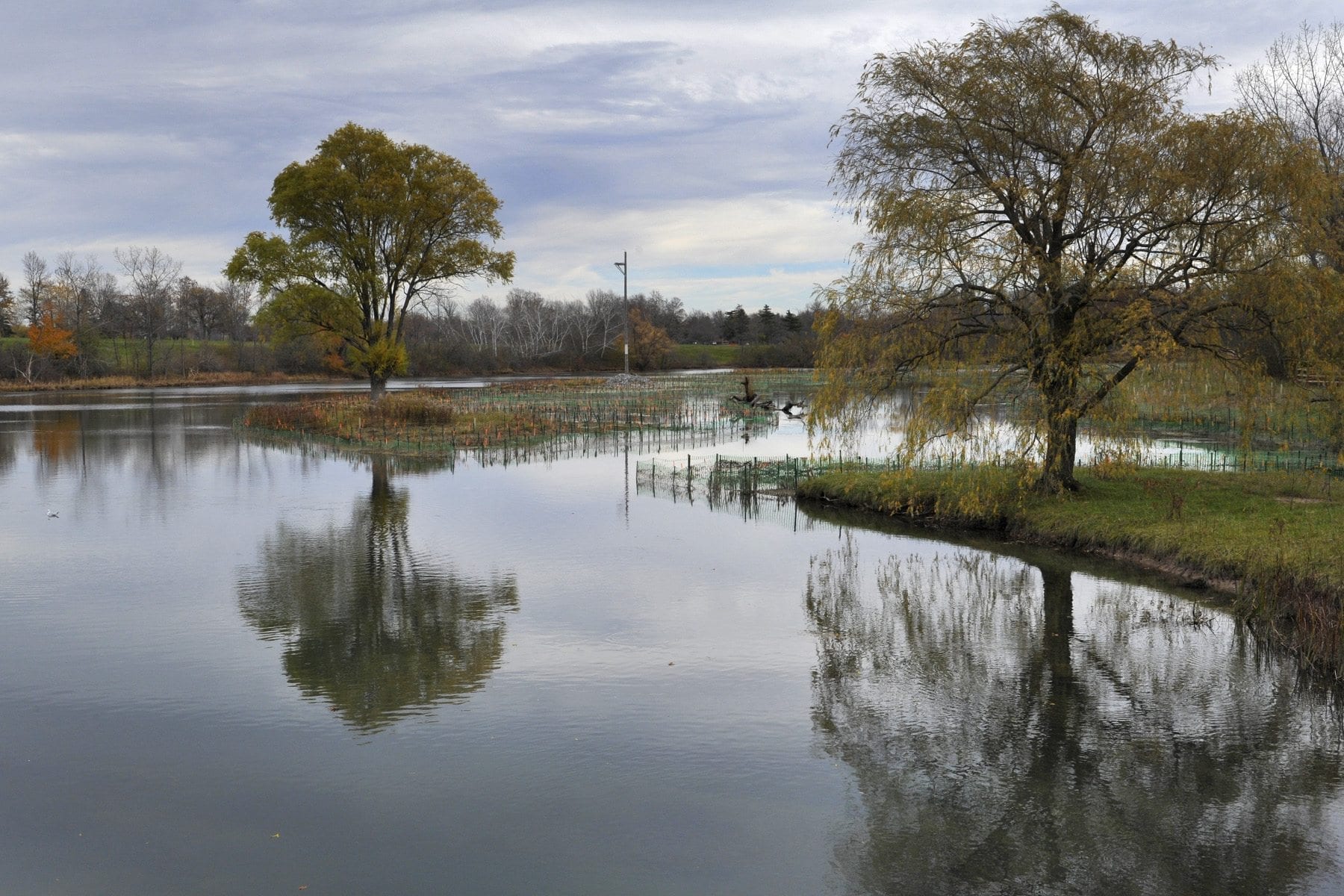Little Beaver Island Habitat Improvement Project
Summary
Innovations at the New York Power Authority’s newly relicensed Niagara Power Project continue on many fronts, including completion of a large wetland restoration project benefitting an array of fish and wildlife species in a region where suitable habitat for such species has been continually diminishing due to development.
NYPA worked through a collaborative process to restore the historic wetland area at Little Beaver Island that had been impacted by human activity. Overcoming many challenges, they were able to design a highly functional wetland configured to provide important aquatic, wetland and riparian habitat; protect the newly installed young plants from fish and bird herbivory; increase recreational benefits to a wider range of park users; protect sections of eroding shoreline that could impact the newly created wetland; minimize disruption to park users during construction; and develop practical, beneficial disposal solutions for over 69,000 cubic yards of excavated fill.
Background
In 1999, the New York Power Authority initiated a collaborative relicensing process for its 2,400 MW Niagara Power Project, the largest producer of electricity in New York State. Together, NYPA and the other stakeholders identified a wide range of ecological, recreational and economic development issues to be addressed.
As part of the collaborative relicensing agreement, NYPA agreed to design and install eight habitat improvement projects (HIPs) that improve important habitat for rare, threatened and endangered (RTE) species, restore valuable wetland and island habitat, and control invasive species.
One of the eight projects, first identified by the New York State Department of Environmental Conservation (DEC), was the Little Beaver Island HIP. This wetland restoration opportunity involved a large, historic wetland area at Little Beaver Island that had been filled in during the 1950s with material dredged from different recreation development sites in the area. Subsequent to its being filled in, the area was maintained primarily as a large mowed lawn as part of the Beaver Island State Park, which is owned and operated by the New York State Office of Parks, Recreation and Historic Preservation (OPRHP).
Challenge
A wide range of challenges was presented by this project. The first was to develop a design that achieved the desired hemi-marsh conditions. This involved preparing a grading plan that exposed the native wetland soil (and its historic native seedbank) below the fill, allowed for a stable configuration, adequate water exchange, and a range of water depths to suit a diverse mix of submerged aquatic and emergent vegetation. The design needed to work in concert with a planting plan that incorporated the proper mix of such vegetation to encourage fish feeding and spawning, attract migratory birds, and provide habitat for fish, amphibians and other wildlife species.
Such a design challenge presented implementation obstacles as well. The fill area of approximately 10 acres required the removal and disposal of over 69,500 cubic yards of soil. If hauled over a significant distance, the costs involved would quickly render the project cost-prohibitive, while also disrupting park operations. New vegetation added as part of the restoration would be vulnerable to native species until fully established and able to survive without protection. The company also needed to identify and add features to the project that would provide immediate recreational benefit to users of the park beyond the medium and long term ecological benefits that would result from the completed wetland restoration.
Innovation
After careful consideration and consultation with a wide range of stakeholders, NYPA and its design team of engineers and biologists developed an excavation and grading plan and a planting plan to accomplish the challenging goals of restoring the hemi-marsh conditions with the right combination of water depths and plant species to achieve a viable and sustainable wetland, and mechanisms to protect the new plants.
Instead of trucking it miles away, the fill material was used to expand an existing sledding hill – making it larger and safer for visitors – and convert a deteriorating asphalt parking lot into a green parking area. An innovative combination of in-water fencing, a flagged grid network of twine, and upland fencing minimized grazing threats to vulnerable vegetation by carp, geese, and deer. Other new park features added for immediate enjoyment by visitors were an ADA-accessible kayak launch, extension of a hiking trail with a raised earth wildlife viewing area which offers a view of another new feature: an osprey nesting pole.
Results
The project to provide additional fish and wildlife habitat through restoration of a former wetland has been a biological and aesthetic success. OPRHP staff reported immediate sightings of more birds than had been previously seen in the restored area, even before the completion of the installation of new plantings. Niagara River flows through the different wetland planting zones have been found to be continuous and adequate to avoid stagnation, fish continue to move freely in and out of the channel, and plant installation has so far yielded a high degree of successful plant establishment. Herbivory by fish and wildlife has been minimal.
Public acceptance of the wetland restoration portions of project has been clearly evident, as indicated by increased recreational use of project areas, and through feedback from kayakers observing wildlife from the water, hikers, and bird watchers. Stakeholder feedback has been uniformly enthusiastic about the immediate aesthetic beauty of the wetland and very positive about the project’s prospects for sustaining high quality wildlife habitat value.
Stakeholder Quote
“The Power Authority and its partners achieved the goal of re-creating an ecologically valuable wildlife habitat on Little Beaver Island, with the added accomplishment of unlocking a vault of plant diversity that has been buried for over 50 years, symbolizing the ultimate potential for renewal of a forgotten landscape. Perhaps the greatest lesson learned from this project is an affirmation that human effort is just as capable of transforming developed areas into natural areas, as it is to do the opposite.” – Ken Roblee, Wildlife Biologist, New York State Department of Environmental Conservation



